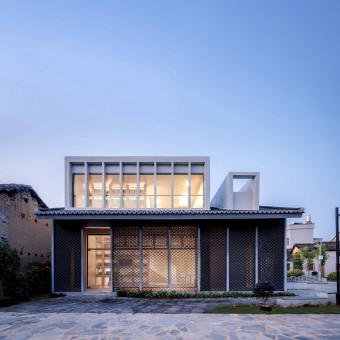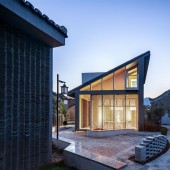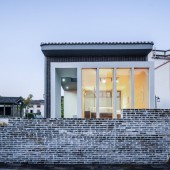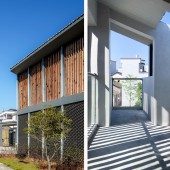DESIGN NAME:
Liru and Guo Dali
PRIMARY FUNCTION:
Rural Library
INSPIRATION:
Under the background of rural revitalization, public space should be designed with the space concept of high accessibility, available for cooperative and collective activities and diversified functions, as well as with the integration of mixed social functions and pursuit of cultural value under rural background. The designer has explored and practiced the design of micro space in rural public spaces in this project.
UNIQUE PROPERTIES / PROJECT DESCRIPTION:
In terms of the organization of spatial form, the project has used the combination of overlapped and embedded double-enclosure structure.The overhanging eaves and the outer enclosure structure form a gray space between indoors and outdoors, which enriches people's spatial experience. Furthermore, it can play the role of shading from the sun and rain, passively reducing energy consumption in north Guangdong, a hot and rainy area. Meanwhile, it also plays a certain role in protecting the wall.
OPERATION / FLOW / INTERACTION:
The government, designer team and villagers have participated in the project from design to construction. As a matter of fact, villagers as the main body of the space of the village understand it most. And the construction of core public space in the village will directly influence the quality of their public life. Therefore, in the process of design and construction, the villagers' subjective initiative was given into play and they participated in the construction with designers. The villagers' enthusiasm for the construction was enhanced, and 12 villagers directly or indirectly participated in the design and construction to give suggestions for the early construction and later maintenance and renewal of the core public space in the village. By improving the space site by site, and environmental cognition was formed for villagers in Xitang Village and other tourists, complementing high-quality places for public activities to the existing rural environment.
PROJECT DURATION AND LOCATION:
The project lasted one and a half years from design to construction (June 2020 to October 2021), which was located in Xitang Village, Dongbei Town, Lianzhou City, Guangdong Province, China. Since its establishment, nearby villagers and children often came to the site to study, rest and entertain, and it has also attracted many tourists from neighboring counties and cities. As an important investigation and study base for educational history research in South China, it has embraced students and tourists from all over the country.
FITS BEST INTO CATEGORY:
Architecture, Building and Structure Design
|
PRODUCTION / REALIZATION TECHNOLOGY:
The poetic of humanity and locality has been shaped in the process of deconstruction and reconstruction. By comparing the old and new materials, a visual conflict is formed to enrich the features. The facade of the building, which is unitarily composed of traditional pottery tiles and Chinese fir strips, bears the culture and history of the village. The simple and heavy fair-faced concrete and light and transparent glass reflect Mr. Lin Liru's educational philosophy, that is, the spirit of breakthrough and innovation, and his expectation a better future for the village; Almost all the materials are from the local area, and the building has ingeniously combined these old and new materials into a new time-and-space narrative and a place for experience.
SPECIFICATIONS / TECHNICAL PROPERTIES:
The climatic conditions in Guangdong were fully considered in the design, and both the two buildings used overlapped double-layer enclosure structures. Based on the principle called "cold lane" from Lingnan traditional architecture, the combination of overlapped and embedded double-enclosure structures was used in the space design. Empty and hollow spaces with different cross-sectional areas were formed. When passing through the spaces, the wind speed will increase and the wind pressure will decrease. The hot air in each room connected with the cold lane will be pushed out, and the cool air will fill in the space, thus the ventilation is done. The outermost enclosure structure of Liru Book House is a hollow facade composed of traditional pottery tiles and Chinese fir strips, which have the sunshade effect. The middle part is an empty space, and the second enclosure structure inside is a floor-to-floor safety glass window. While ensuring the shading from sun and rain, it can also ensure indoor lighting.
TAGS:
Compound function, micro-building, passive energy saving, overlapped double-enclosure structure, folding lines, multi-group viewfinder, modern interpretation, locality, site spirit
RESEARCH ABSTRACT:
In terms of the construction of rural public space, the building was orderly constructed with multiple sites to create a flexible spatial structure; Secondly, the concept of micro-intervention with less physical construction and more natural landscape was adopted to return the space to villagers' activities, which defined the various functions of the building; Finally, the project used the landscape space method to create diversified interactive media such as constructions and facilities, which enhanced the extensibility of core public space, meeting the needs of various spaces and cultures, and enhancing villagers' happiness. The rich spatial scales are conducive to the subdivision of spatial functions, stimulating villagers to use the spaces, and promoting the diversity of people's communication and activities.
CHALLENGE:
1. Due to the large scale of the site, it was not easy for this project to meet the main functions of the building (exhibition) and the needs of villagers and visitors (reading, recreation, spiritual experience and activities), as well as to highlight the monumental significance of the building.
2. The overall design thinking stems from a respect for rural culture. The design volume and storey height of the public buildings in this project are different from the traditional residences around the site. If the functions of the traditional dwellings are to be met, reference cannot be made to their scale. In addition, the harmony between the new building and its surroundings should be taken into account.
ADDED DATE:
2022-06-28 05:32:13
TEAM MEMBERS (1) :
Xiangming Ma, Hui Wang, Xin Huang,Jianwei Yang,Xiaojun Wu, Rongbin Li, Lei Wang, Huilv Yan, Junan Ren,Delin Wang, Wenxin Zhu, Zepen Wu, Xianghui Wu, Shouan Zhong, Jun Huang, Weifeng Huang, Shujie Hu, XianbiaoXu, Zijian Zhang and Boya Deng
IMAGE CREDITS:
GDUPI, 2022.
|










